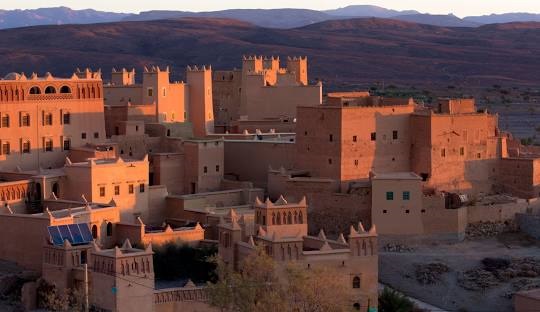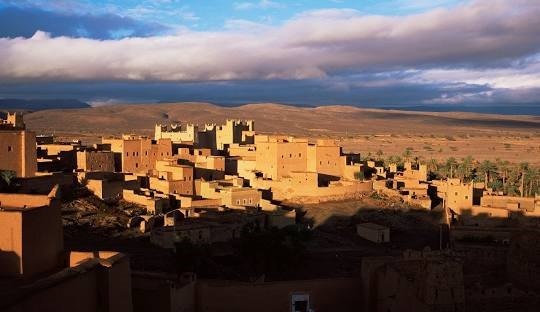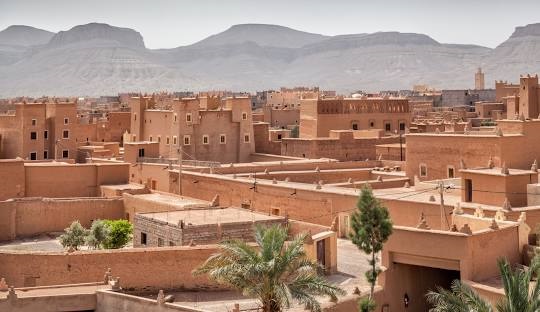The Atlas mountain range, housing Riad Nkob, is one of the most remarkable and defining geographic features of North Africa, stretching across the northwestern part of the African continent. This extensive range spans through three countries : Morocco, Algeria, and Tunisia, serving as a natural barrier between the Mediterranean Sea and the vast Sahara desert.
Atlas Mountain Range
The Atlas mountain range is not only renowned for its majestic peaks, breathtaking landscapes, and unique ecosystems but also for the rich cultural history that has developed around it, extending over approximately 2,500 kilometers and divided into several sub-ranges : the High Atlas, Middle Atlas, Anti-Atlas, Tell Atlas, Saharan Atlas, and Aures mountains.
The most famous and highest sub-range of the Atlas mountain range is the High Atlas, located primarily in central Morocco. The Middle Atlas, to the north of the High Atlas, is lower in elevation but still an essential part of the region’s topography. South of the High Atlas lies the Anti-Atlas, which gradually merges into the Sahara desert. The Tell Atlas and Saharan Atlas are located farther east, spanning Algeria and into Tunisia.
Among the Atlas mountain range, the Tell Atlas is a series of parallel ranges that run along the Mediterranean coast, while the Saharan Atlas runs inland, closer to the Sahara desert. Finally, the Aures mountains, located in eastern Algeria and Tunisia, are smaller but geologically significant due to their role in separating the coastal and desert regions.
The geology of the Atlas mountains is complex, formed over millions of years through the collision of the African and Eurasian tectonic plates, causing intense folding and faulting, giving rise to the rugged terrain we see today. The mountains are primarily composed of sedimentary rock such as limestone, sandstone, and shale, although volcanic and metamorphic rock can also be found in certain areas.
At the highest points of the Atlas mountain range, in the High Atlas, such as Jebel Toubkal, which stands at 4,167 meters above sea level, snow can persist year-round, creating a stark contrast to the arid regions nearby. The difference in elevation between the High Atlas and the surrounding lowlands creates diverse microclimates and ecosystems, fostering a wide range of plant and animal life.
The Atlas mountains are known for their dramatic climate variations, with regions experiencing everything from Mediterranean climates to arid desert conditions. The coastal regions of the Tell Atlas benefit from the influence of the Mediterranean Sea, with mild, wet winters and hot, dry summers. As one moves inland, the climate becomes more extreme, with colder winters, particularly in the higher altitudes of the High Atlas.
In the Atlas mountain range, the High Atlas receives substantial precipitation, especially in winter, which often falls as snow at higher altitudes. In the Middle and Anti-Atlas, the climate is more semi-arid, with less rainfall and more significant temperature fluctuations between day and night. The Saharan Atlas, bordering the Sahara desert, is characterized by extremely hot summers and cold winters with minimal rainfall.
The Atlas mountains play a crucial role in shaping the regional climate. Acting as a barrier to the humid Mediterranean air, the mountains prevent this moisture from reaching the interior, contributing to the desertification of the Sahara to the south. Conversely, the northern slopes of the range benefit from increased rainfall, fostering lush forests and agricultural areas.
The Atlas mountain range is home to a rich diversity of plant and animal life, thanks to their varying climates and elevations. The northern slopes, especially in the Middle and High Atlas, are covered in forests of oak, cedar, and juniper trees. The cedar forests in particular, most notably the Atlas cedar, are iconic and provide crucial habitats for wildlife.
These forests also offer a stark contrast to the more barren landscapes found at lower elevations and in the southern ranges. In the higher elevations of the High Atlas, alpine meadows and herbaceous plants thrive during the short summer growing season, while the lower, drier areas of the Anti-Atlas are dominated by hardy shrubs and desert vegetation.
Still in the Atlas mountain range, the Tell Atlas has more Mediterranean vegetation, including olive and fig trees, while the Saharan Atlas has a more arid-adapted flora. The fauna of the Atlas mountains is equally diverse, with perhaps the most famous inhabitant being the Barbary macaque, a type of primate found in the forests of the Middle Atlas and High Atlas.
This species, which is also found in the mountains of Algeria and a few other regions, is considered endangered due to habitat loss and human activity. Other animals found in the Atlas mountains include the Barbary sheep and leopard, Cuvier’s gazelle, and various bird species such as the golden and bonelli’s eagle. The mountain streams and rivers also support aquatic life, including the endemic Atlas trout.
The lower regions and more arid parts of the Atlas mountain range are home to animals adapted to harsher conditions, such as the fennec fox and various species of reptiles. The Atlas mountains are also a crucial migratory route for birds, making it an essential area for birdwatching. They have been inhabited by humans for thousands of years, and their rugged terrain has helped preserve the unique cultures of the people who call these mountains home.
The indigenous Berber people, also known as the Amazigh, have lived in the Atlas mountains for millennia, and their culture and traditions are deeply intertwined with the landscape. The Berber people have historically been semi-nomadic, with many practicing pastoralism and agriculture in the mountain valleys.
Terraced farming is common in the Atlas mountain range, with crops such as barley, wheat, and olives being grown in the higher elevations, while fruits like figs, dates, and almonds are cultivated in the lower regions. The Berbers have developed an intricate system of water management, using traditional irrigation methods to make the most of the limited water resources in these often dry and rocky areas.
One of the most distinctive aspects of Berber culture is their language, Tamazight, which has numerous dialects depending on the region. The Berber language was historically unwritten, but in recent years, efforts have been made to preserve and promote it, including the effective adoption of the Tifinagh script.
Despite the pressures of modernization and the spread of Arabic, Berber culture and language remain resilient, particularly in the more remote parts of the Atlas mountain range. The Berber people are also known for their distinctive architecture, particularly the traditional mud-brick houses and fortified villages. These structures are not only aesthetically striking but also well-suited to the harsh climate of the mountains, insulating both heat and cold.
Throughout history, the Atlas mountains have also been a strategic region for various civilizations. The ancient Phoenicians, Romans, and later the Arabs all sought control over the fertile valleys and trade routes that passed through the mountains. In more recent times, the Atlas mountains have been a site of resistance, with the Berbers playing a significant role in resisting foreign rule, including during the French colonial period in the 19th and 20th centuries.
In the modern era, the Atlas mountain range have become a popular destination for tourists, especially for those seeking adventure and an escape from the urban bustle of Moroccan cities. The rugged beauty of the mountains, combined with their proximity to cities like Marrakech and Fez, makes them an attractive destination for hikers, climbers, and nature lovers.
The most popular trekking destination in the Atlas is Jebel Toubkal, the highest peak in North Africa. Climbers from around the world come to ascend this mountain, and the trek offers stunning views of the surrounding mountains and valleys. Other popular outdoor activities include mountain biking, skiing in the winter months, and visits to Berber villages.
The Atlas mountain range is also rich in natural resources, including minerals such as phosphate, lead, and zinc, which have historically been extracted from the mountains. While mining remains a significant industry in some areas, it has also brought various environmental challenges, including deforestation and habitat loss.
Efforts are being made to preserve the natural beauty and biodiversity of the Atlas mountains, with several areas designated as national parks or nature reserves. The Toubkal National Park in Morocco, for example, is a protected area that aims to conserve the unique flora and fauna of the High Atlas while promoting sustainable tourism.
The Atlas mountain range is much more than just a series of peaks and valleys. It is a region of extraordinary geographic, ecological, and cultural diversity that has played a crucial role in the history of North Africa. From its dramatic landscapes and unique ecosystems to the resilient cultures of the Berber people who have lived there for millennia, the Atlas mountains remain one of the most significant and beautiful natural features of the African continent.



